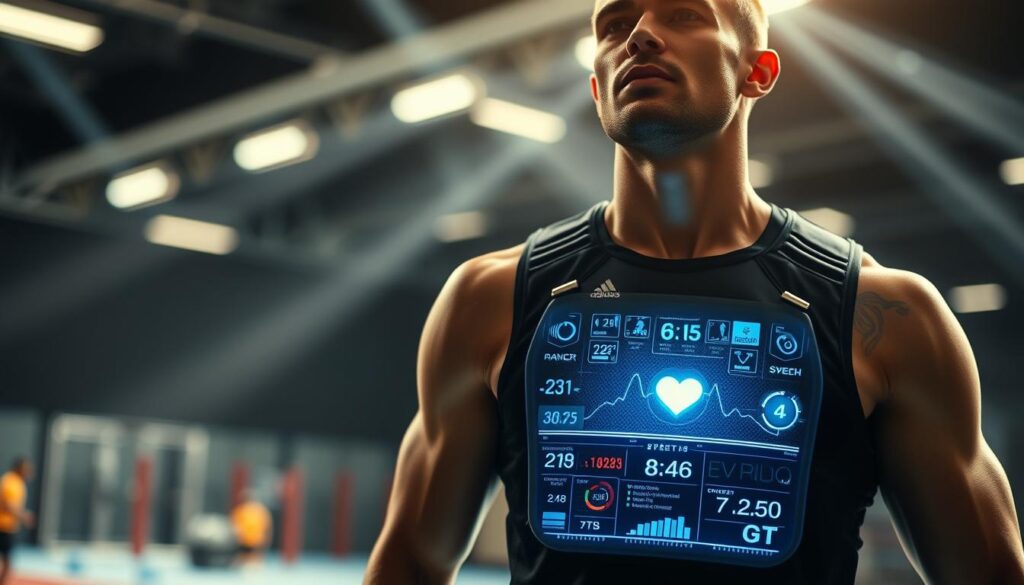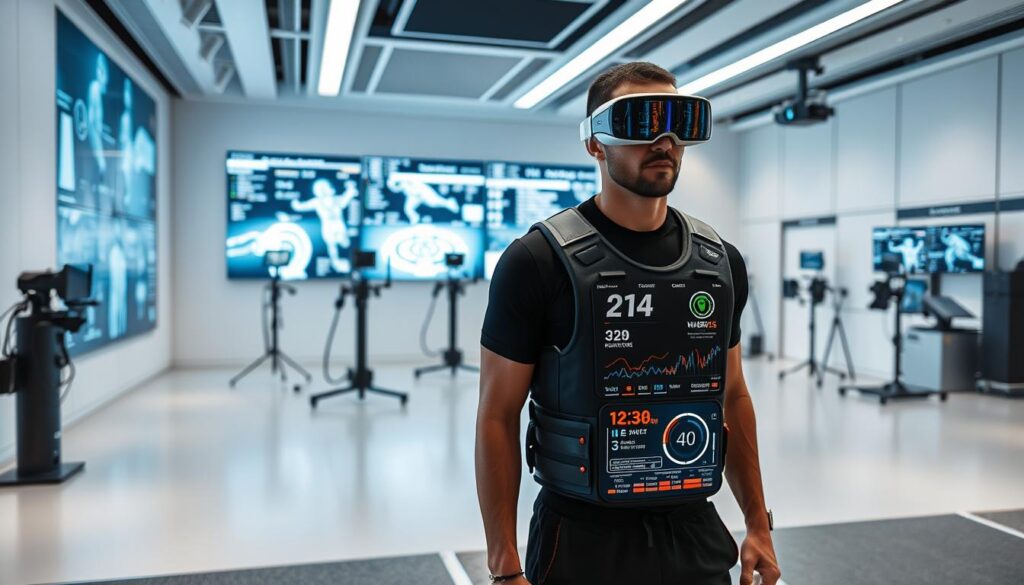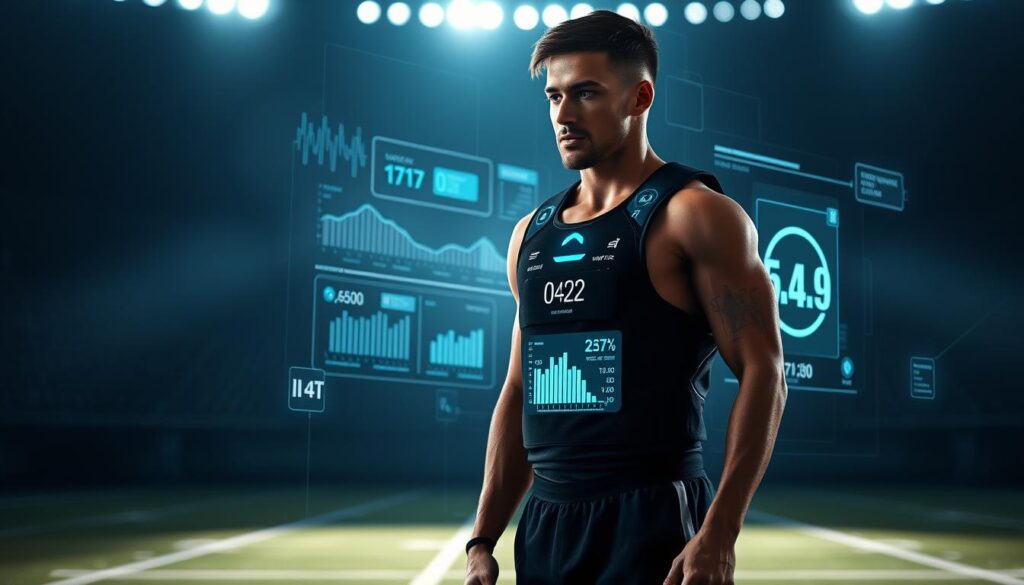Imagine a coach walking onto the field with a single question: “How do we make every practice count?” A cracked bat, a smart ball ping, and a coach peering at a live readout changed one afternoon into a plan. That split-second data helped the team fix a swing and avoid an injury the next week.
This guide maps how connected equipment, sensors, and devices will reshape player performance. We cover the full stack — from wearables and instrumented gear to venue sensors and cloud platforms. Expect clear examples, like sensor-equipped bats and smart balls, and practical ways organizations use data to improve health and fitness.
Over the next few years, teams and leagues will lean on technology to turn raw metrics into immediate insights for coaches and players. This section previews seven system categories, the value they deliver, and what development teams must consider to build reliable solutions.
![]()
Key Takeaways
- Connected equipment and sensors will change how coaches make decisions in real time.
- Player systems include wearables, smart equipment, optical platforms, and integrated solutions.
- Data and device interoperability matter for safe, actionable performance insights.
- Industry momentum is driven by performance gains, health benefits, and new revenue models.
- Evaluating systems requires attention to sensors, development, reliability, and real-world workflows.
Why performance tracking matters now: present-day benchmarks, future payoffs
Coaches now rely on live metrics to shape daily training and reduce injury risk. Clear, objective data helps teams move from guesswork to repeatable gains. Sensors in gear, clothing, and venues capture movement, ball speed, and environment to inform smarter sessions.

User intent and outcomes center on three goals: enhance performance, prevent injuries, and optimize recovery. Good programs let coaches tailor load and drills to each player’s readiness.
User intent and outcomes
- Enhance performance: use heart rate, speed, and movement metrics to refine plans.
- Prevent injuries: watch fatigue, workload, and movement quality to reduce injury risk.
- Optimize recovery: track sleep and activity balance to support readiness.
KPI snapshot
Key metrics include heart rate, movement patterns, speed, fatigue markers, load distribution, and technical accuracy. These measures give coaches actionable insights to adjust intensity, volume, or focus.
Data quality, consent, and role-based access are essential. Simple, useful dashboards win adoption and produce the incremental wins that compound across seasons.
Top 7 player performance tracking systems shaping the next few years
A new class of devices captures precise movement and recovery data every day. These categories map where teams get useful signals, from readiness scores to impact alerts. Below are the seven system types coaches and staff should evaluate.
![]()
Wearable biometrics and smart wearables
What they measure: heart rate, sleep quality, and muscle activity. Baseline levels and daily deltas reveal fatigue and recovery trends.
Coaches use those deltas to set session intensity and rest windows that help athletes avoid injuries.
Smart sports equipment with embedded systems
Rackets, shoes, and clubs now include processors and sensors to measure swing mechanics, gait, and impact at the moment of action.
Examples like NBA smart basketballs and instrumented bats validate on‑field use and feed technique adjustments.
Optical and sensor-based player & ball tracking
RFID tags, IMUs, and computer vision fuse to map movement, speed, and spatial positioning with high fidelity during drills and games.
Edge video analytics and coaching tools
Low‑latency video processing lets coaches tag clips, review form, and share insights quickly. Mobile dashboards speed decisions in practice.
Safety and injury‑prevention devices
Smart helmets and knee braces detect risky loads and impact forces. Early alerts change drill plans and reduce injury risk.
Environmental and venue monitoring
Temperature, humidity, and air quality sensors help staff adjust workloads and hydration protocols in real time — Wimbledon offers a successful example.
Integrated recovery and health ecosystems
Central platforms combine wearable and equipment data into one readiness profile. That unified view helps coaches plan workloads across levels and the season.
- Interoperability matters: open data lets teams move information across devices and platforms without vendor lock‑in.
- Decisions enabled: load adjustments, technique fixes, altered drills, and targeted recovery plans that help athletes maintain performance.
Best practices to evaluate systems: accuracy, latency, and reliability
Evaluate systems by focusing first on measurement fidelity and how that fidelity holds up under real practice loads.

Ground-truthing matters. Demand validation that benchmarks accuracy against gold-standard measurements. Ensure sampling rate and rate stability match the motion speed you need to capture.
Ground-truthing performance metrics
Use synchronized references—high-speed cameras or lab sensors—to verify incoming data streams.
Sensor fusion (IMUs, RFID, and video) improves signal quality, but verify alignment across streams to avoid misleading insights.
Edge vs. cloud trade-offs
Decide what must run at the edge for low-latency feedback and what can run in the cloud for deep modeling and historical analysis.
Concrete targets help set expectations: well-architected systems can reach 93.45% accuracy with 12.34 ms time-to-feedback and 98.37% data reliability when edge and cloud are balanced.
“Validate sampling rates, monitor drift, and pilot at increasing complexity so staff trust the numbers in real sessions.”
- Calibration & reliability: periodic calibration, drift detection, and environmental compensation.
- Coach guidance: interpret confidence intervals and error bounds before changing drills.
- Operational checks: battery life, sensor placement, and uptime must match training demands.
- Documentation: record validation methods and outcomes for transparent procurement decisions.
Run pilots before scale. Start small, collect data, and iterate so the system delivers consistent insights without adding staff friction.
AI sports tracking, IoT athlete monitoring, mobile sports analytics
Well-architected systems bridge on-device sensing and team dashboards so decisions happen in seconds. Design starts with clear layers that move raw signals into useful guidance for coaches and athletes.
Designing a unified stack: sensors, data pipelines, models, and apps
Sensors capture reliable motion and bio signals. Data pipelines clean, align, and timestamp inputs for consistent use.
Machine learning models then turn that stream into cues, readiness scores, and event tags. Role-based apps expose simple actions for coaches, compact cues for athletes, and detailed trends for performance staff.
From insights to action: coach and athlete feedback loops in real time
Place low-latency models at the edge for instant corrections and keep deeper models in the cloud for season-long patterns.
“Small, timely feedback—rep by rep—changes technique more than weekly reports.”

| Layer | Role | Example |
|---|---|---|
| Sensors | Capture | IMU in connected shoes |
| Pipeline | Clean & Sync | Gateway timestamping |
| Models & Apps | Translate & Act | Edge rep cue; coach dashboard |
Integration uses standard APIs and data formats, plus governance for model versioning, A/B tests, and drift checks. Prioritize privacy-by-design and secure provisioning so staff trust every alert during practice and games.
Embedded intelligence in sports equipment: from processors to practical gains
Embedded processors now let gear make sense of motion in real time, right on the device. Low-power chips and optimized firmware capture high-fidelity signals while keeping batteries alive across long sessions.

Precision tracking and energy-efficient wearables
Precision matters. On-device signal conditioning and sensor fusion record swing plane, ground contact timing, and muscle activation with minimal latency.
That precision helps coaches link technique changes to performance and recovery outcomes. Wearable sensors for heart rate, temperature, and motion feed session logs and readiness scores in team platforms.
- Energy-efficient design: low-power MCUs and duty-cycled sensors extend runtime and reduce charging tasks.
- Hybrid processing: rep-level cues run on-device; deeper models run in the cloud for season trends.
- Accuracy practices: calibration, consistent placement, and robust filtering sustain reliable measurements in real play.
Durability and ergonomics ensure devices survive impacts, weather, and cleaning without losing function. Integrated apps visualize progress, flag anomalies, and help staff act faster.
| Feature | Practical Gain | Design Consideration |
|---|---|---|
| On-device processing | Instant rep feedback | Low-latency firmware, power budget |
| Precision sensors | Quantified technique metrics | Calibration, placement consistency |
| Wearable biometrics | Better load & recovery planning | Comfort, skin contact quality |
| Durable enclosures | Reliable field use | Materials, sealing, sanitation |
Iterative field development proves value: validate that embedded solutions change movement, reduce errors under fatigue, and improve readiness across busy schedules.
Connectivity choices that make or break accuracy and battery life
Connectivity choices shape how reliably devices deliver real‑time cues during practice and competition.
Short-range: Bluetooth Low Energy (BLE) is best for on‑body sensors and wearables. BLE keeps pairing stable and conserves battery so session flow stays smooth.
High-throughput: Wi‑Fi fits smart gym equipment and stations where video or bulk uploads support immediate review by coaches and staff.
Long-range options and low power
NB‑IoT works well for city‑wide coverage and reliable long‑distance telemetry from equipment in the field. LoRaWAN extends to 10–15 km and suits endurance events with infrequent packets and long battery life.
5G and edge computing for time-sensitive feedback
Use 5G and edge gateways when rep‑level feedback must happen in milliseconds. Edge processing reduces lag so cues arrive within a rep, enabling actionable corrections.
- Security & interference: plan encryption and channel management for crowded arenas to protect data integrity.
- Battery vs bandwidth: right‑size each system—high bandwidth for video, low power for remote sensors.
- Fail-safe tips: local buffering and deferred sync prevent data loss during outages.
“Match connectivity to the device role: the right network lowers cost, extends uptime, and helps prevent injuries by delivering timely alerts.”
From lab to field: proven use cases and measurable results
Field trials prove that well‑integrated systems deliver clear, repeatable gains for teams and staff. Real deployments show how reliable data and fast feedback change coaching plans and reduce risk.
Pro teams and events
NBA smart basketballs embed sensors that quantify touch, rotation, and speed to speed player development and refine technique.
NFL shoulder pads with Zebra RFID capture position, movements, and collision profiles to support tactics and help prevent injuries.
Wimbledon uses environmental devices to guide scheduling, hydration, and heat rules so players and fans stay safer during extreme conditions.
Academic benchmark and field translation
A hybrid TCN + BiLSTM + Attention model proved 93.45% accuracy with 12.34 ms latency across 147 athletes in track, basketball, soccer, and swimming. The study balanced edge responsiveness with cloud analytics and reached 98.37% reliability.
Validated machine learning models move from lab prototypes to field systems when pipelines, synchronization, and robust data handling are included. That process preserves accuracy and shortens time-to-action for coaches.
- Heart rate and workload metrics map to player levels and fatigue so staff can tune session intensity.
- Movement metrics from devices and wearables identify skill gaps and prescribe targeted drills.
- Reliability and sync across streams are essential so staff trust live numbers during games and practice.
“Start with proven applications, then iterate development to match your competitive context and staffing model.”
Implementation playbook for U.S. programs: integration, compliance, and scaling
A clear rollout plan turns promising prototypes into reliable tools that coaches and staff actually use. Build a stepwise development path that ties market research to pilot outcomes and a staged rollout. Start small, learn fast, and expand only after staff trust the system.
Data privacy, consent, and role-based access
Protect sensitive health and performance records. Implement consent flows and role-based apps so coaches, physicians, and trainers see only what they need.
Document retention, audit logs, and institutional policy alignment must be baked into contracts and training plans.
Systems integration with existing devices, apps, and workflows
Plan for APIs, unified data models, and vendor-neutral formats to reduce friction. Map current workflows and meet staff where they operate.
- Development checklist: needs assessment, hardware selection, software build, pilot testing, refinement, and rollout.
- Operational expectations: uptime SLAs, support hours, and scheduled updates during off‑season.
- Procurement & governance: success metrics, data ownership terms, exit clauses, and clinical review of injury thresholds.
- Scale & observability: network planning, device provisioning, secure updates, and dashboards for system health.
- Change management: training for coaches and athletes, clear docs, and feedback channels tied to iterative improvements.
“Partner with experienced vendors and industry experts to speed development and meet compliance while protecting player welfare.”
Conclusion
Today’s platforms turn raw signals into short, actionable instructions coaches can use rep to rep.
Connected equipment, embedded sensors, and real-time models deliver clear insights that improve consistency and on-field performance. These advances create faster feedback loops and support smarter training choices.
Teams benefit most when solutions fit daily workflows. Integration with staff routines turns data into planned drills, targeted recovery, and better load management for athletes.
Start with high-impact use cases, validate accuracy and latency, then scale. Well-validated systems with clear benchmarks protect decision quality and help athletes perform while lowering risk.
Invest in interoperable design and coach-centric tools to extract lasting value. Ongoing evaluation ensures each upgrade measurably enhances performance and recovery across a season.
FAQ
What metrics should coaches prioritize when choosing a player performance tracking system?
Coaches should focus on heart rate, movement patterns, speed, fatigue, external load, readiness, and accuracy. Also consider sleep and recovery metrics, muscle activity, and contextual data like environmental conditions. These KPIs help detect fatigue, guide training load, and reduce injury risk while improving conditioning and technique.
How do wearable biometrics compare to optical and sensor-based tracking?
Wearable biometrics provide direct physiological signals such as heart rate and muscle activity and excel at monitoring recovery and internal load. Optical and sensor-based systems — including IMUs, RFID tags, and computer vision — offer precise positional data and ball tracking. Combining both via sensor fusion yields richer insights and better validation of movement and exertion metrics.
What accuracy and latency targets are realistic for real-time feedback?
Aim for sampling rates and fusion methods that keep latency under a few tens of milliseconds for timely coaching cues. Accuracy depends on the metric — positional tracking often targets sub-meter precision, while heart-rate variability requires consistent sampling. Validate systems against ground-truth lab measures and field tests to confirm reliability.
Should teams prioritize edge processing or cloud analytics?
Use edge processing for low-latency coach feedback, safety alerts, and battery savings. Cloud analytics suits long-term modeling, heavy machine learning, and cross-player comparisons. Many programs adopt a hybrid stack: immediate inference at the edge, deeper analysis and model training in the cloud.
How can smart equipment like connected shoes or racket sensors improve performance?
Embedded sensors capture force, orientation, and stroke mechanics directly from the tool, enabling precise technique analysis and actionable coaching cues. These devices can detect asymmetries, load spikes, and technique drift to prevent overuse injuries and optimize equipment choices and fit.
What role do environmental and venue sensors play in training programs?
Environmental monitoring tracks temperature, humidity, air quality, and surface conditions to adjust load, hydration, and recovery plans. These inputs help coaches tailor sessions, reduce heat-related risks, and ensure consistent training conditions for reliable metrics.
How do safety systems like smart helmets and braces reduce injury risk?
Smart safety devices measure impact forces, joint loads, and abnormal movement patterns to trigger alerts or modify practice intensity. When combined with load and fatigue metrics, they enable proactive interventions, targeted rehab, and data-informed return-to-play decisions.
What are best practices for validating a new monitoring system?
Ground-truth bench tests, cross-validate with laboratory tools, and run field trials across different playing surfaces and intensities. Check sensor fusion stability, sampling consistency, and repeatability. Document validation protocols to meet compliance and stakeholder confidence.
How do teams address data privacy and consent when deploying tracking systems?
Implement role-based access, encrypted data storage, and clear consent procedures. Limit personal data sharing, anonymize datasets for research, and follow HIPAA or state privacy laws where applicable. Transparent policies build trust among players and staff.
What connectivity options best balance battery life and data needs?
Choose BLE for short-range, low-power telemetry; Wi‑Fi for high-throughput sessions; NB‑IoT or LoRaWAN for sparse telemetry over long ranges; and 5G when ultra-low latency and large data transfers are required. Match the protocol to session goals and power constraints.
Can small programs scale these systems affordably?
Yes. Begin with modular stacks: low-cost wearables, mobile apps for local analysis, and selective cloud services. Prioritize metrics that drive the biggest outcomes, integrate with existing devices, and phase investments as ROI becomes clear.
How do recovery ecosystems integrate with daily coaching workflows?
Recovery platforms synthesize sleep, HRV, muscle soreness, and load to produce readiness scores and action plans. Deliver concise, coach-friendly insights via mobile apps and automated alerts to guide session adjustments and personalized rehab plans.
Transform Your IoT Vision Into Reality.
Get free expert insights, architectures & cost breakdowns.
Drop your email to schedule free meeting.